2000 YAMAHA XVZ1300A transmission
[x] Cancel search: transmissionPage 15 of 91
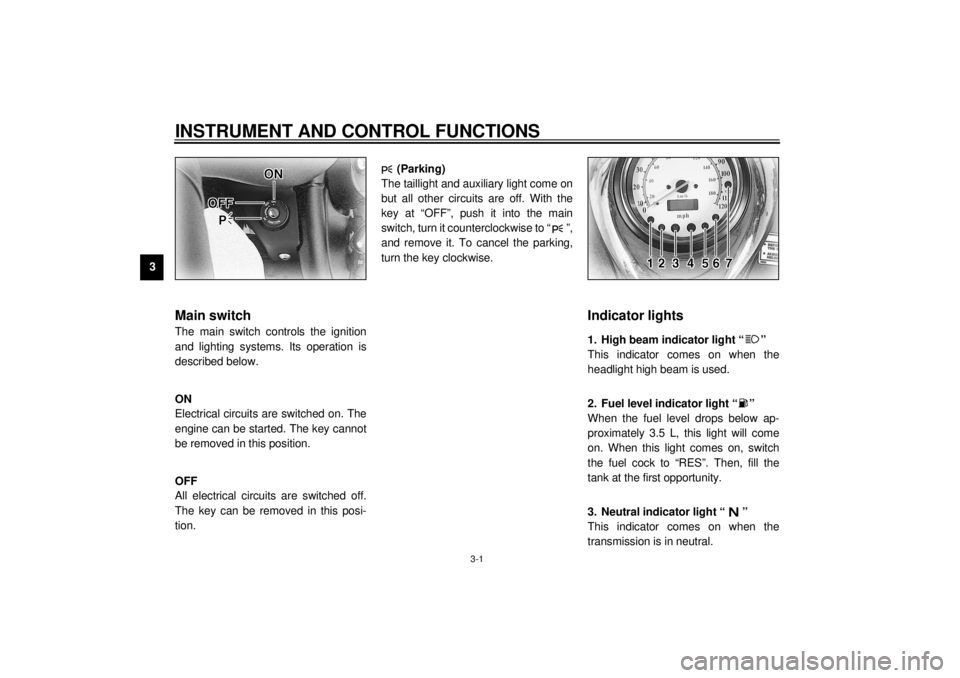
3-1
3
EAU00027
3-INSTRUMENT AND CONTROL FUNCTIONS
EAU00028
Main switchThe main switch controls the ignition
and lighting systems. Its operation is
described below.
EAU00036
ON
Electrical circuits are switched on. The
engine can be started. The key cannot
be removed in this position.
EAU00038
OFF
All electrical circuits are switched off.
The key can be removed in this posi-
tion.
EAU00054*
(Parking)
The taillight and auxiliary light come on
but all other circuits are off. With the
key at “OFF”, push it into the main
switch, turn it counterclockwise to “ ”,
and remove it. To cancel the parking,
turn the key clockwise.
EAU00056
Indicator lights
EAU00063
1. High beam indicator light “ ”
This indicator comes on when the
headlight high beam is used.
EAU00079
2. Fuel level indicator light “ ”
When the fuel level drops below ap-
proximately 3.5 L, this light will come
on. When this light comes on, switch
the fuel cock to “RES”. Then, fill the
tank at the first opportunity.
EAU00061
3. Neutral indicator light “ ”
This indicator comes on when the
transmission is in neutral.
E_4YP_Functions.fm Page 1 Wednesday, October 6, 1999 10:03 AM
Page 16 of 91

INSTRUMENT AND CONTROL FUNCTIONS
3-2
3
EAU00057
4. Turn indicator light “ ”
This indicator flashes when the turn
switch is moved to the left or right.
EAU01209
5. Oil level indicator light “ ”
This indicator light will come on if the oil
level is low. To check that the indicator
light is working properly:l
Turn the engine stop switch to “ ”
and the main switch to “ON”.
l
Put the transmission in neutral or
apply the clutch lever.
l
Push the start switch.
If the indicator light does not come on
while pushing the start switch, have a
Yamaha dealer inspect the electrical
circuit.
NOTE:@ Even if the oil is filled to the specified
level, the indicator light may flicker
when riding on a slope or during sud-
den acceleration or deceleration, but
this is normal. @
EAU01257
6. Engine overheat indicator light
“”
This indicator light will come on if the
engine overheats. If the light comes on,
stop the engine immediately and allow
the engine to cool. To check that the in-
dicator light is working properly:l
Turn the engine stop switch to “ ”
and the main switch to “ON”.
l
Put the transmission in neutral or
apply the clutch lever.
l
Push the start switch.
If the indicator light does not come on
while pushing the start switch, have a
Yamaha dealer inspect the electrical
circuit.
EAU01272
7. Overdrive / Engine trouble indica-
tor light “O/D / ”l
This indicator light will come on
when the transmission is in over-
drive (5th gear).
l
This indicator light will also come
on or flash if trouble occurs in an
engine monitoring circuit. In such
a case, take the motorcycle to a
Yamaha dealer to have the self-di-
agnostic systems checked.
E_4YP_Functions.fm Page 2 Wednesday, October 6, 1999 10:03 AM
Page 29 of 91
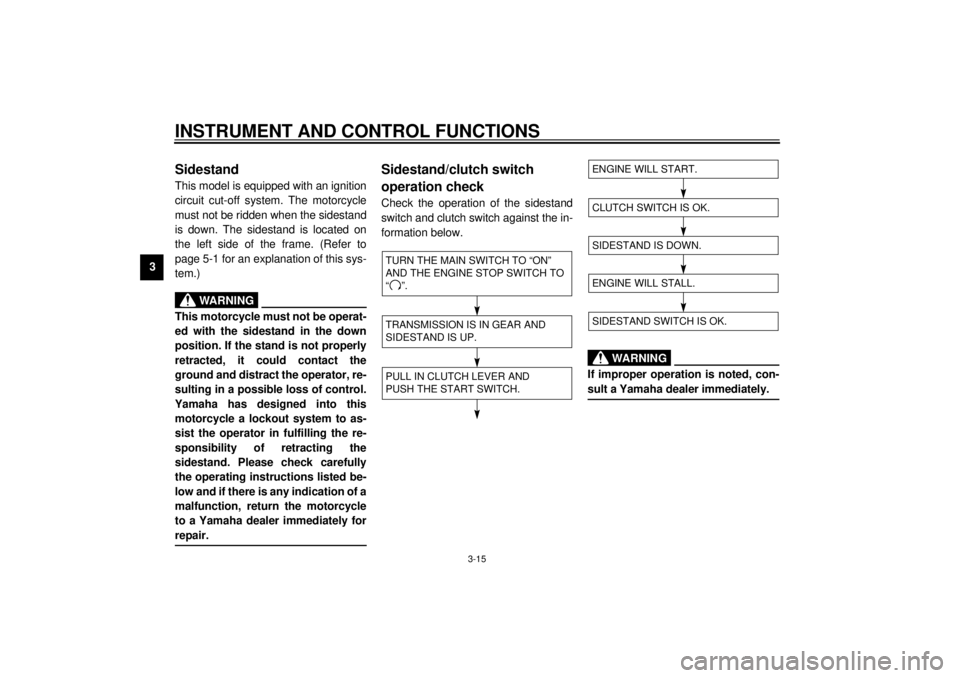
INSTRUMENT AND CONTROL FUNCTIONS
3-15
3
EAU00330
SidestandThis model is equipped with an ignition
circuit cut-off system. The motorcycle
must not be ridden when the sidestand
is down. The sidestand is located on
the left side of the frame. (Refer to
page 5-1 for an explanation of this sys-
tem.)
EW000044
WARNING
@ This motorcycle must not be operat-
ed with the sidestand in the down
position. If the stand is not properly
retracted, it could contact the
ground and distract the operator, re-
sulting in a possible loss of control.
Yamaha has designed into this
motorcycle a lockout system to as-
sist the operator in fulfilling the re-
sponsibility of retracting the
sidestand. Please check carefully
the operating instructions listed be-
low and if there is any indication of a
malfunction, return the motorcycle
to a Yamaha dealer immediately for
repair. @
EAU00331
Sidestand/clutch switch
operation checkCheck the operation of the sidestand
switch and clutch switch against the in-
formation below.CD-11E
CD-11E
EW000045
WARNING
@ If improper operation is noted, con-
sult a Yamaha dealer immediately. @
TURN THE MAIN SWITCH TO “ON”
AND THE ENGINE STOP SWITCH TO
“”.TRANSMISSION IS IN GEAR AND
SIDESTAND IS UP.PULL IN CLUTCH LEVER AND
PUSH THE START SWITCH.
ENGINE WILL START.SIDESTAND IS DOWN.ENGINE WILL STALL.SIDESTAND SWITCH IS OK.CLUTCH SWITCH IS OK.
E_4YP_Functions.fm Page 15 Wednesday, October 6, 1999 10:03 AM
Page 35 of 91
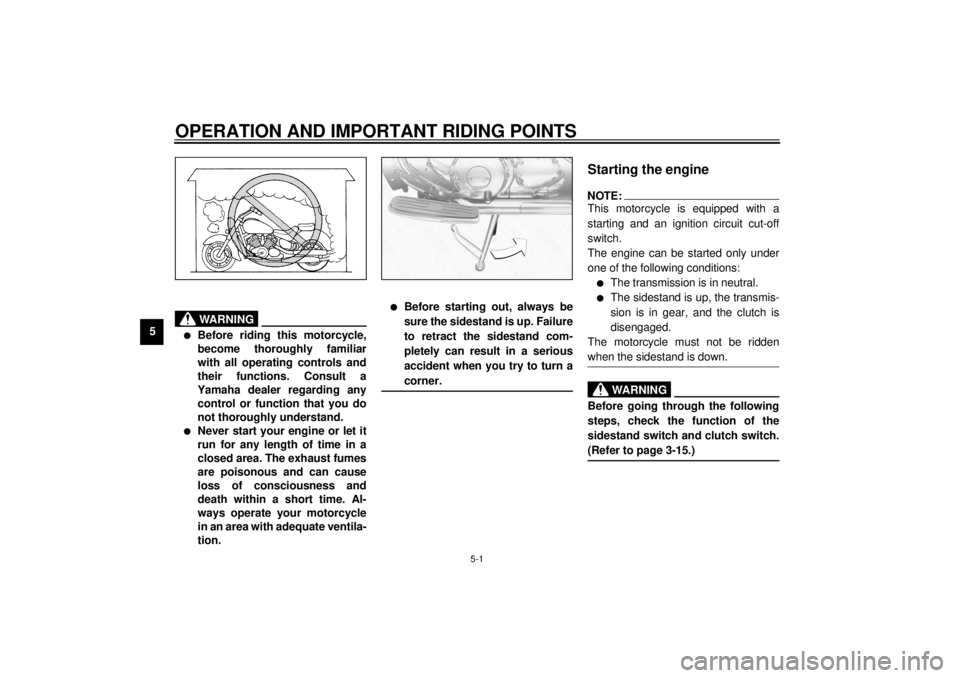
5-1
5
EAU00372
5-OPERATION AND IMPORTANT RIDING POINTS
EAU00373
WARNING
@ l
Before riding this motorcycle,
become thoroughly familiar
with all operating controls and
their functions. Consult a
Yamaha dealer regarding any
control or function that you do
not thoroughly understand.
l
Never start your engine or let it
run for any length of time in a
closed area. The exhaust fumes
are poisonous and can cause
loss of consciousness and
death within a short time. Al-
ways operate your motorcycle
in an area with adequate ventila-
tion.
l
Before starting out, always be
sure the sidestand is up. Failure
to retract the sidestand com-
pletely can result in a serious
accident when you try to turn a
corner.
@
EAU01588
Starting the engineNOTE:@ This motorcycle is equipped with a
starting and an ignition circuit cut-off
switch.
The engine can be started only under
one of the following conditions:l
The transmission is in neutral.
l
The sidestand is up, the transmis-
sion is in gear, and the clutch is
disengaged.
The motorcycle must not be ridden
when the sidestand is down.
@
EW000054
WARNING
@ Before going through the following
steps, check the function of the
sidestand switch and clutch switch.
(Refer to page 3-15.) @
E_4YP_Operation.fm Page 1 Wednesday, October 6, 1999 10:05 AM
Page 36 of 91

OPERATION AND IMPORTANT RIDING POINTS
5-2
5 1. Turn the fuel cock to “ON”.
2. Turn the main switch to “ON” and
the engine stop switch to “ ”.
EC000037
CAUTION:@ If the fuel level indicator light comes
on, check the fuel level. If neces-
sary, add fuel. @3. Shift transmission into neutral.NOTE:@ When the transmission is in neutral, the
neutral indicator light should be on. If
the light does not come on, ask a
Yamaha dealer to inspect it. @
4. Turn on the starter (choke) and
completely close the throttle grip.
5. Start the engine by pushing the
starter switch.NOTE:@ If the engine fails to start, release the
starter switch, wait a few seconds, then
try again. Each attempt should be as
short as possible to preserve the bat-
tery. Do not crank the engine more
than 10 seconds on any one attempt. @
ECA00003
CAUTION:@ The oil level indicator light and en-
gine overheat indicator light should
come on when the start switch is
pushed and should go off when the
start switch is released. If the oil lev-
el indicator light flickers or remains
on, immediately stop the engine and
check the engine oil level and for oil
leakage. If necessary, fill the engine
with oil and check to see that the oil
level indicator light goes off. If not,
consult a Yamaha dealer. @
E_4YP_Operation.fm Page 2 Wednesday, October 6, 1999 10:05 AM
Page 37 of 91
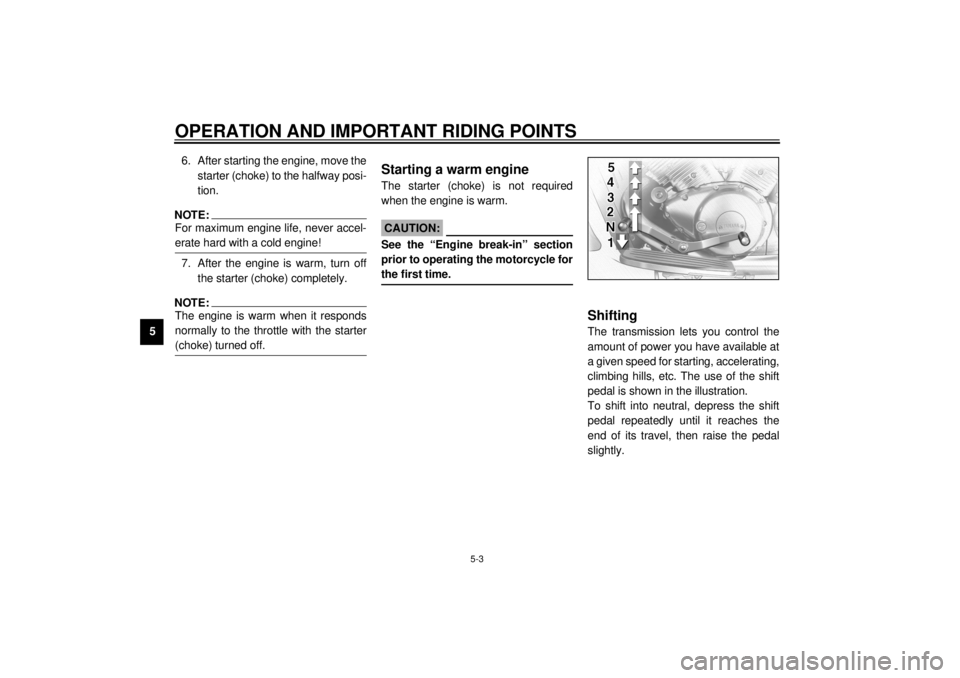
OPERATION AND IMPORTANT RIDING POINTS
5-3
56. After starting the engine, move the
starter (choke) to the halfway posi-
tion.
NOTE:@ For maximum engine life, never accel-
erate hard with a cold engine! @7. After the engine is warm, turn off
the starter (choke) completely.NOTE:@ The engine is warm when it responds
normally to the throttle with the starter
(choke) turned off. @
EAU01258
Starting a warm engineThe starter (choke) is not required
when the engine is warm.
EC000046
CAUTION:@ See the “Engine break-in” section
prior to operating the motorcycle for
the first time. @
EAU00423
ShiftingThe transmission lets you control the
amount of power you have available at
a given speed for starting, accelerating,
climbing hills, etc. The use of the shift
pedal is shown in the illustration.
To shift into neutral, depress the shift
pedal repeatedly until it reaches the
end of its travel, then raise the pedal
slightly.
E_4YP_Operation.fm Page 3 Wednesday, October 6, 1999 10:05 AM
Page 38 of 91
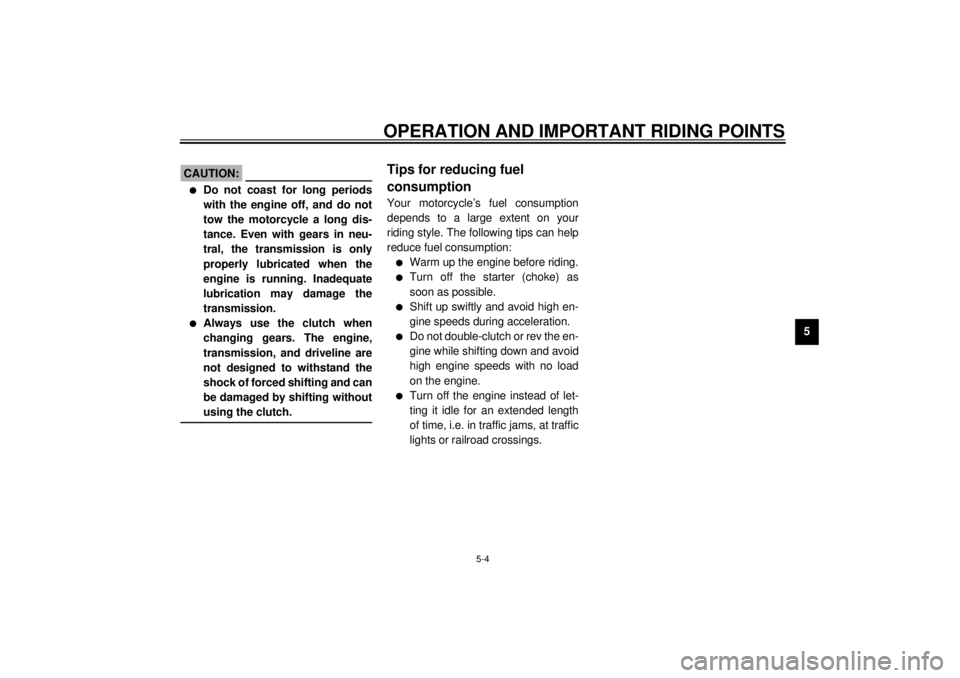
OPERATION AND IMPORTANT RIDING POINTS
5-4
5
EC000048
CAUTION:@ l
Do not coast for long periods
with the engine off, and do not
tow the motorcycle a long dis-
tance. Even with gears in neu-
tral, the transmission is only
properly lubricated when the
engine is running. Inadequate
lubrication may damage the
transmission.
l
Always use the clutch when
changing gears. The engine,
transmission, and driveline are
not designed to withstand the
shock of forced shifting and can
be damaged by shifting without
using the clutch.
@
EAU00424
Tips for reducing fuel
consumptionYour motorcycle’s fuel consumption
depends to a large extent on your
riding style. The following tips can help
reduce fuel consumption:l
Warm up the engine before riding.
l
Turn off the starter (choke) as
soon as possible.
l
Shift up swiftly and avoid high en-
gine speeds during acceleration.
l
Do not double-clutch or rev the en-
gine while shifting down and avoid
high engine speeds with no load
on the engine.
l
Turn off the engine instead of let-
ting it idle for an extended length
of time, i.e. in traffic jams, at traffic
lights or railroad crossings.
E_4YP_Operation.fm Page 4 Wednesday, October 6, 1999 10:05 AM
Page 82 of 91

SPECIFICATIONS
8-2
8
Final gear oil
Type SAE80API “GL-4” Hypoid Gear
Oil
Quantity 0.2 L
Radiator
capacity (including all routes) 2.9 L
Air filterDry type element
Fuel
Type Regular unleaded gasoline
Fuel tank capacity 18 L
Reserve amount 3.5 L
Carburetor
Type ´ quantity BDS28 ´ 4
Manufacturer MIKUNI
Spark plug
Manufacturer/Type NGK / DPR7EA-9 or
DENSO / X22EPR-U9
Gap 0.8 ~ 0.9 mm
Clutch typeWet, multiple-disc
Transmission
Primary reduction system Spur gear
Primary reduction ratio 1.667
Secondary reduction system Shaft drive
Secondary reduction ratio 2.567Transmission type Constant mesh 5-speed
Operation Left foot operation
Gear ratio
1st 2.438
2nd 1.579
3rd 1.160
4th 0.906
5th 0.750
Chassis
Frame type Double cradle
Caster angle 30°
Trail 126 mm
Tires
Front
Type Tubeless
Size 150/80-16 71H
Manufacturer /
modelDunlop / D404F
Rear
Type Tubeless
Size 150/90B15M/C 74H
Manufacturer /
modelDunlop / D404
E_4YP_Spec.fm Page 2 Wednesday, October 6, 1999 10:06 AM